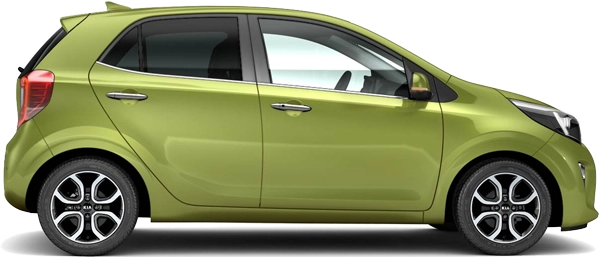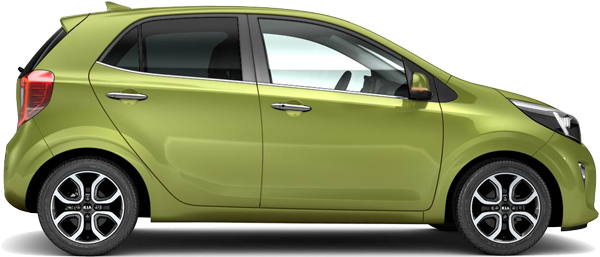Die Vergleichsanalyse :
Ford Ka 1.2 (14 - 16) vs. KIA Picanto 1.0 T-GDI ISG (17 - 18)
9.900 €

16.100 €

9.900 €
Grundpreis ⓘListenpreis für das Basismodell (Standardausstattung ohne Extras) zum Zeitpunkt der Markteinführung in Deutschland.
16.100 €
ⓘListenpreis für das Basismodell (Standardausstattung ohne Extras) zum Zeitpunkt der Markteinführung in Deutschland. Preisinfo
Abmessungen
Der Ford Ka 1.2 Start/Stopp ist etwas größer. Er ist 2.5 cm länger, 6.3 cm breiter und 2.1 cm höher als der KIA Picanto 1.0 T-GDI ISG.
Ford Ka 1.2 Start/Stopp
KIA Picanto 1.0 T-GDI ISG
1506
1658
1890
1485
1595
1880
1658 mm
Breite
1595 mm
1890 mm
Breite mit Spiegeln
1880 mm
1506 mm
Höhe
1485 mm
2300
3620
2400
3595
3620 mm
Länge
3595 mm
2300 mm
Radstand
2400 mm
Gewicht
Ford Ka 1.2 Start/Stopp
KIA Picanto 1.0 T-GDI ISG
1015 kg
Leergewicht
1020 kg
1320 kg
Zulässiges
Gesamtgewicht
Gesamtgewicht
1405 kg

Gewichtsdifferenz:
5 kg
0.49 %

Allgemein
Ford Ka 1.2 Start/Stopp
KIA Picanto 1.0 T-GDI ISG
RU8
Baureihe
JA
Schrägheck
Karosserie
Schrägheck
Super (ROZ 95)
Kraftstoff
Super (ROZ 95)

Frontantrieb
Antrieb
Frontantrieb

5-Gang-Schaltgetriebe
Getriebe
5-Gang-Schaltgetriebe
Motor
Ford Ka 1.2 Start/Stopp
KIA Picanto 1.0 T-GDI ISG
Reihenvierzylinder-Benziner (Saugmotor)
Motorbauart
Reihendreizylinder-Benziner mit Turboaufladung
2
Ventile
4
4
Zylinder
3
1242 cm³
Hubraum
998 cm³
69 PS
bei 5500 U/min
Leistung
100 PS
bei 4500 U/min
Ford Ka 1.2 Start/Stopp
69 PS
100 PS
KIA Picanto 1.0 T-GDI ISG
102 Nm
bei 3000 U/min
Drehmoment
172 Nm
bei 1500 U/min
Ford Ka 1.2 Start/Stopp
102 Nm
172 Nm
KIA Picanto 1.0 T-GDI ISG
Leistungsfähigkeit
Ford Ka 1.2 Start/Stopp
KIA Picanto 1.0 T-GDI ISG
159 km/h
Höchstgeschwindigkeit
180 km/h
13.4 s
Beschleunigung 0 – 100 km/h
10.1 s
100 km/h
100
km/h
km/h
186 m
0.000 s

Ford Ka 1.2 Start/Stopp
100 km/h
100
km/h
km/h
140 m
0.000 s

KIA Picanto 1.0 T-GDI ISG
▶ REPLAY
14.71 kg/PS
Leistungsgewicht
10.2 kg/PS
Ford Ka 1.2 Start/Stopp
14.71 kg/PS
10.2 kg/PS
KIA Picanto 1.0 T-GDI ISG
Verbrauch / Umwelt
Ford Ka 1.2 Start/Stopp
KIA Picanto 1.0 T-GDI ISG
Verbrauch pro 100 km
4.9 L
kombiniert
4.5 L
Ford Ka 1.2 Start/Stopp
4.9 L
4.5 L
KIA Picanto 1.0 T-GDI ISG
5.8 L
innerorts
5.6 L
4.4 L
außerorts
4 L
35 L
Tankgröße
35 L
714 km
Reichweite
778 km
Ford Ka 1.2 Start/Stopp
714 km
778 km
KIA Picanto 1.0 T-GDI ISG
Auswirkung auf die Umwelt
57.7 kWh
Gesamtenergieverbrauch
pro 100 km ⓘDer Gesamtenergieverbrauch pro 100 km ergibt sich aus der Energie, die ein Fahrzeug bei der Verbrennung eines Treibstoffs (bzw. bei der Verwendung von Strom) pro 100 km verbraucht (Endenergie) und der Energie, die für die Erzeugung und Bereitstellung entsprechender Menge Treibstoffs (bzw. Stroms) benötigt wird (Primärenergie). Dabei werden auch die Vorprozesse der Treibstoffherstellung, der Transport eines Treibstoffs bis zur Tankstelle (bzw. der Transport des Stroms bis zur Steckdose) und die Verluste, die dabei auftreten, berücksichtigt. Der Gesamtenergieverbrauch ermöglicht somit einen Vergleich der Energieeffizienz von Fahrzeugen mit verschiedenen Antriebssystemen.
pro 100 km ⓘDer Gesamtenergieverbrauch pro 100 km ergibt sich aus der Energie, die ein Fahrzeug bei der Verbrennung eines Treibstoffs (bzw. bei der Verwendung von Strom) pro 100 km verbraucht (Endenergie) und der Energie, die für die Erzeugung und Bereitstellung entsprechender Menge Treibstoffs (bzw. Stroms) benötigt wird (Primärenergie). Dabei werden auch die Vorprozesse der Treibstoffherstellung, der Transport eines Treibstoffs bis zur Tankstelle (bzw. der Transport des Stroms bis zur Steckdose) und die Verluste, die dabei auftreten, berücksichtigt. Der Gesamtenergieverbrauch ermöglicht somit einen Vergleich der Energieeffizienz von Fahrzeugen mit verschiedenen Antriebssystemen.
53 kWh
Ford Ka 1.2 Start/Stopp
57.7 kWh
53 kWh
KIA Picanto 1.0 T-GDI ISG
Euro 6b (NEFZ)
Schadstoffklasse
Euro 6b (NEFZ)
115 g/km (NEFZ)
CO2-Emissionen
104 g/km (NEFZ)
Alltagsnutzen
Ford Ka 1.2 Start/Stopp
KIA Picanto 1.0 T-GDI ISG
3
Türen
5
4
Sitzplätze
5
305 kg
Maximale Zuladung
385 kg
224 L
Kofferraumvolumen
255 L






Кeine Daten
Stauraum mit umgeklappter
Rücksitzbank
Rücksitzbank
1010 L




















